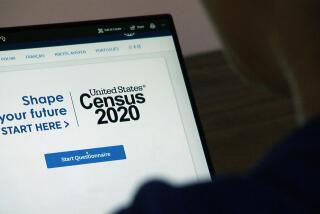Forget ‘Multiracial’ and Count Each Component : Census: People, not the government, should define who they are for the most accurate racial portrait of America.
A federal task force recommends against adding a multiracial category to census forms. Some think the Census Bureau should instead eliminate racial categories altogether. Otherwise, they say, the census reinforces the faulty idea that race is a biologically meaningful concept. In fact, the current categories--American Indian or Alaskan Native, Asian or Pacific Islander, black or African American, and white--are not absolutes; they reflect histories of cultural struggle and blur as many differences as they define. This is why I support the task force’s recommendation to allow individuals to check as many census categories as they think apply to themselves. This exercise in self-definition will expose the limitations of the categorical approach.
A brief look at history vividly illuminates the limitations of categorization. Four categories in the 1890 census applied to African Americans: “Black,” “mulatto,” “quadroon” and “octoroon” reflected whites’ preoccupation with miscegenation and “racial purity.” At various times, Irish, Armenians, Syrians, Mexicans and persons from India have been legally deemed nonwhite, which carried serious consequences, especially for purposes of immigration and citizenship. After the 1940 census removed Mexican as an option, Mexican Americans complained. Today, the census adds Hispanic and non-Hispanic as another set of options, following the initial racial question. Over the 207 years since census takers started their business, 26 categories have been used.
Given these fluctuations and the loaded and charged meanings of the categories, it is essential to ask who does the identifying. If the government assigns individuals to categories of race or ethnicity, we should not be surprised if injury, constraint and official mythology result. The crucial breakthrough occurred in 1980 when the census called for self-identification. Even in the case of follow-up interviews, the enumerators were told to ask respondents how they identified themselves rather than issue their own conclusion based on observation.
Lying or misrepresentation in self-identification pose little risk where the census data are used cumulatively, as in enforcement of the Fair Housing Act and the Voting Rights Act, and for reporting on the patterns of inequality across lines that society has made significant in the past.
The constraints of limited categories seem to be chafing a lot of people. Some 9.8 million respondents, roughly one in 25, bypassed the four categories used in 1990 and instead checked “other race.” This represented a 45% increase since 1980, and the lion’s share of this group were young people. More and more Americans have parents and grandparents of different racial and ethnic groups. Some, like Tiger Woods, want to claim their multiple heritages. Others, for varied reasons, do not. The Census Bureau estimates that 75% of African Americans have ancestors of other races; yet the convention in place since slavery leads to their identification, usually, as black.
Some argue that the best way to draw a racially accurate picture is to ask multiple questions on the census form. In her recent book, “Hybrid,” law professor Ruth Colker proposes three:
“What is your self-identity?
“If your self-identity is different than your community identity, what is your community identity?
“What are the countries of origin of your parents, to the extent you are aware of them?”
I don’t think that such questions would be well understood. Many if not most people have never thought to distinguish self-identification from community identification, and even these distinctions do not clearly describe how you see yourself and how others see you. Some people would want to choose as self-identities categories that are not even included in this portion of the census; for many people, the primary identification comes in the form of religion, occupation, sexuality or the national origin of the ancestor who looms largest in family memories.
Creating a category for “mixed” or “multiracial” will not work because it would not yield information about which or how many racial categories are represented in the individual respondent.
I have no doubt that the current set of categories will change in the future, just as they depart from those used in the past. In the meantime, there is a lot of sense in the task force proposal that people should be able to check one or more racial or ethnic category. Many children whose parents have different racial or ethnic identities powerfully describe their confusion or anger when a form gives them no choice but to reject one of their parents when identifying themselves.
Checking more than one box will complicate some things; the numbers of respondents will not match up with the numbers of boxes checked. Still, the responses can be divided by the actual numbers of people counted by the census. The resulting fractions will help remind anyone using census information of its source in self-identification and the roughness of its truths.


